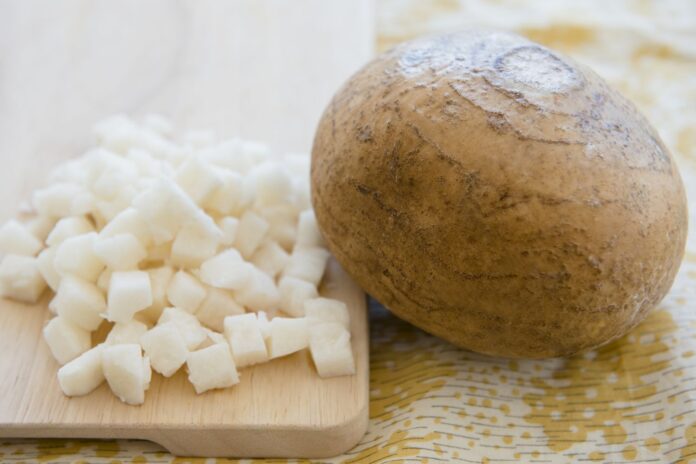Jicama (Pachyrhizus erosus), also known as the Mexican yam bean or Mexican turnip, is a root vegetable native to Mexico and Central America. Belonging to the legume family (Fabaceae), it is prized for its crisp texture and subtly sweet, nutty flavor. Jicama has a starchy and juicy interior surrounded by a thin, fibrous brown skin, which is usually peeled before consumption.
Interesting Facts About Jicama:
- Jicama, also called Pachyrhizus erosus, is a root vegetable native to Central and South America, specifically Mexico, where it has been cultivated for centuries
- The vegetable is often referred to as the “Mexican turnip” or “yam bean” and was introduced to Asia by Spanish explorers
- Jicama has a crisp, juicy texture similar to water chestnuts and a mildly sweet, nutty flavor
- Its nutrient profile includes low calories, high dietary fiber, and abundant vitamin C, making it a healthy addition to any diet
- A single cup of raw jicama contains approximately 49 calories and about 6 grams of dietary fiber
- Jicama is 80-90% water, which helps keep the body hydrated, especially in hot climates
- Rich in antioxidants, including vitamin C, it helps combat free radicals and supports immune function
- The inulin fiber in jicama promotes gut health by supporting beneficial gut bacteria
- Ancient Chinese medicine recognized jicama for its potential to brighten skin and reduce scars when used topically
- It has a low glycemic index, making it a great option for people managing blood sugar levels
- Jicama is also a natural diuretic, aiding in kidney function and reducing bloating
- In traditional Mexican cuisine, it is enjoyed raw with chili powder, lime juice, and salt
- Jicama is versatile in the kitchen—it can be added to salads, salsas, and stir-fries, or eaten as a raw snack
- In the Philippines, it is often pickled with rice vinegar and used in spicy salads
- Jicama seeds and skin contain rotenone, a natural insecticide toxic to humans, and should never be consumed
- This root vegetable is popular during Mexico’s Día de los Muertos (Day of the Dead) celebrations
- Jicama can last for weeks when stored uncut in a cool, dark place
- When choosing jicama, smaller and medium-sized bulbs are preferred for their tender, sweet flesh
- Jicama’s prebiotic properties make it a favorite among nutritionists for promoting digestive health
- Its consumption may help reduce the risk of certain cancers due to its antioxidant content
- Historically, jicama has been used in folk remedies for cooling the body and calming muscle aches
- In Latin America, jicama is often paired with fruits like mango and pineapple in refreshing street food dishes
- It supports bone health due to its vitamin C content, which aids in collagen production
- Regular consumption of jicama may help prevent osteoporosis and arthritis
- Jicama’s light, crisp texture makes it an excellent substitute for chips when paired with dips
- The plant thrives in tropical and subtropical climates, requiring well-drained soil
- Jicama is believed to have been a part of the diet of the Mayan and Aztec civilizations
- It is a favorite ingredient in health-conscious recipes due to its low carbohydrate and fat content
- Jicama can also be roasted or sautéed, resembling roasted potatoes when cooked
- It is a key ingredient in some Filipino street snacks, such as lumpia (spring rolls)
